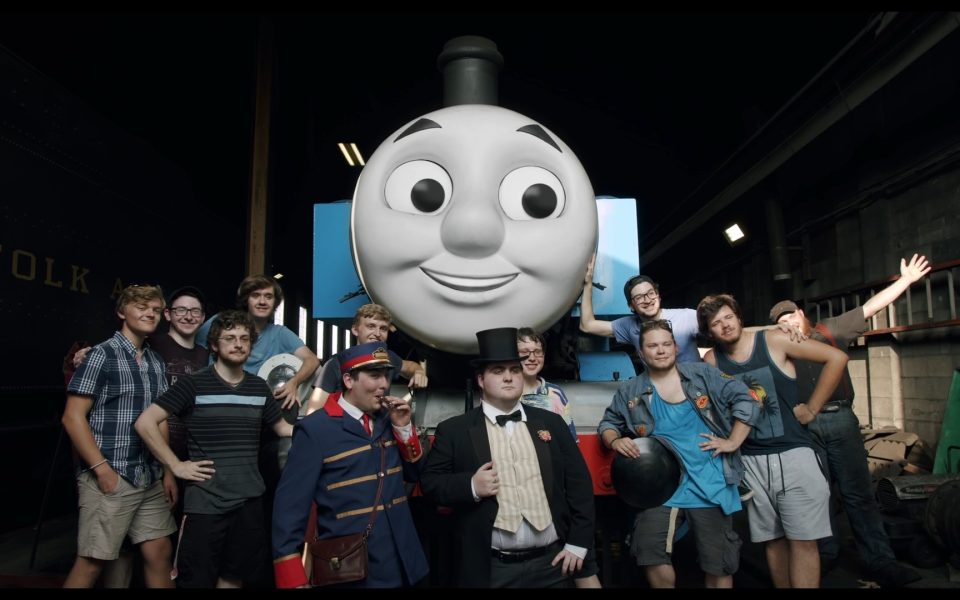Featured photo: A group of fans, including Brannon Carty, pose with a life-sized Thomas at Strasburg Rail Road in Pennsylvania. (film still)
When Brannon Carty was 4 years old, his parents threw him a Thomas the Tank Engine-themed birthday party. Plates featuring the prominent characters plus cups and a Thomas-themed cake filled out the spread on the family dinner table.
That’s around the time the switch flipped.

“Our parents gave my brother and I Thomas stuff since we were born,” says Carty, who grew up in Greensboro. “My brother grew out of it, and I inherited all of the Thomas stuff. Then I got to fifth grade and I was like, I still like this. Most people my age don’t like this anymore.”
Now, at the age of 27, Carty’s obsession with Thomas is at its peak.
In his apartment, he keeps a shelf dedicated to his Thomas collection. Neatly organized rows of DVDs of “Thomas & Friends” — which ran across 24 series from 1984-2021 — line the bottom shelves. Upper shelves are dedicated to VHS tapes, miniatures and model trains. One of his favorite items is a children’s book dedicated to learning about colors.
“I had it as a kid and I thought, I’d love to have this again to put on a shrine I had at home,” he says.
He found one on eBay for $5 in mint condition.

Another prized possession is an electrical-powered Thomas train from the ’90s that had a limited run. He keeps the model safe next to his bed.
Soon, he’ll get to add another memorabilia to his collection.
In November, Carty’s passion for all things Thomas culminated in a special screening of the documentary An Unlikely Fandom: The impact of Thomas the Tank Engine, a film that he had been making for the last four years.

It started as an assignment for his media studies course at UNCG. As part of his independent study in his final semester, Carty was directed to do a project of some kind. His professor, Kevin Wells, suggested he make a documentary.
“I had the perfect canvas,” Carty explains. “I am an adult Thomas the Tank Engine fan. I know other adult Thomas the Tank Engine fans. What if I told our story without making us a joke or feeling too praise-y?”
For the next four years, Carty spent most of his free time traveling, interviewing and shooting footage for the documentary.
A not-so-niche fandom
He started with friends he had made online through forums dedicated to Thomas. It was a realm he started exploring in middle and high school.
“My parents gave me unrestricted internet access at the age of 11 which is a horrible thing,” he jokes. “I was going on YouTube — this was around 2006 — and found people reenacting a Thomas episode of making their own. So I made my own YouTube channel and made my own videos. And then I found forums where people would talk about new episodes that were coming out. It just snowballed, and it never stopped.”
He had met his online friends a few times in person and at an electric train convention in New Jersey that was started in 2019. That first year, Carty says, there were only about 15 Thomas fans at the event. But as viewers can see in the documentary, the Thomas footprint grows larger, with almost a third of the convention center being dedicated to the fandom in 2023.

Beyond his personal circle, Carty posted on Twitter about his plans for making the film. That’s how he got put in touch with a group of fans who were working on recreating scenes from the show in a gymnasium. To capture the footage, Carty flew out to “the middle of nowhere” in Pennsylvania.
As more and more people started to get in touch with him for the film, he began to realized just how far-reaching the fandom actually was.
“It was getting bigger and bigger,” he says. “I thought, I don’t think this is a niche thing anymore.”

As the documentary began to take shape, he realized that he couldn’t make the film without acknowledging Thomas the Tank Engine’s British roots.
He started a Kickstarter campaign to help pay for flights to the United Kingdom in March of 2020; they ended up raising $14,000. Then, the pandemic hit.
“That’s when the hard stuff happened,” Carty says. “We wanted to interview people from the UK, but we didn’t know when the world would open back up.”
But like the group that reached out to him from Pennsylvania, luck offered her hand once again.
As Carty pondered how to get footage from the UK, a documentarian with the BBC reached out to him and told Carty about his connection to the Thomas community. He had filmed a documentary about the niche group in the ’90s and still had connections. They hired him immediately.
In fall 2021, they got footage back from the UK, which was shot at Talyllyn Railway, a location that inspired a part of the show.
By this time, the film was already 90 minutes long.

“That’s when I realized that Australia was also a big Thomas location,” Carty says.
They hired more filmmakers abroad to fill in the gaps and added more footage to the film.
By the time all was said and done, Thomas fans from Pennsylvania, Maryland, California, New Jersey, Nebraska, New York, the UK and Australia were represented in the film. But then another twist happened.
“The creator of the show reached out to me,” Carty says.
A special screening with a special guest
He was getting off his shift at the Cheesecake Factory when Britt Allcroft sent Carty an email praising his work, giving him her blessing.
“I immediately responded and asked her if she would want to be in the film,” Carty says.
Now this was a big ask, partially because Allcroft was all the way in LA, but also because she was monklike in nature, hardly ever doing public appearances or interviews. The last time she had made a public appearance was about 20 years ago, according to Carty. But they had to try.
“We went to California, rented an Airbnb and set up a shoot,” he says. “It was like a Star Wars fan interviewing George Lucas.”
When Carty asked Allcroft if she’d like to come to the screening in November, she was over the moon about it.
And on Nov. 27, the film was shown in a private screening to friends and family… and one other very special guest.
“When she came out, people went crazy,” he says. “People were cheering, clapping; it was like the Super Bowl in there. It was great to reintroduce her to the fandom.”

After the showing, many of the parents whose kids had been interviewed for the film came up to Carty to thank him for what he had done.
“They said, ‘I’m glad you made my child feel validated,’” Carty says.
And that’s because many of the biggest Thomas the Tank Engine Fans are on the autism spectrum, Carty explains.

“It was something that people would talk publicly about,” he says. “There’s always been a link between Thomas and autism.”
Part of the reason, Carty thinks, is that the show is colorful but not flashy. That, and the fact that in the original series, the faces on the engines don’t move. Their eyes move, but not their mouths.
“There was some expression in the face, but it wasn’t too much, just enough for someone who might not understand facial cues to say, ‘That engine is happy or that engine is angry,’” Carty says.
Now, after four years of working on the film — and one prescription for anxiety medication later — Carty says he’s working on finding a home for An Unlikely Fandom. He’s currently submitting it to film festivals and is actively looking for a distributor.
“If you had told me in 2019 that this is what would happen, I would have said you were crazy,” Carty says. “I would have said, it’s just a silly Thomas thing. It’s crazy; now, looking back on it, I don’t think I could ever reproduce that kind of luck again.”
Learn more about An Unlikely Fandom and follow updates at unlikelyfandom.com and on Facebook and Twitter.
Join the First Amendment Society, a membership that goes directly to funding TCB‘s newsroom.
We believe that reporting can save the world.
The TCB First Amendment Society recognizes the vital role of a free, unfettered press with a bundling of local experiences designed to build community, and unique engagements with our newsroom that will help you understand, and shape, local journalism’s critical role in uplifting the people in our cities.
All revenue goes directly into the newsroom as reporters’ salaries and freelance commissions.


Leave a Reply